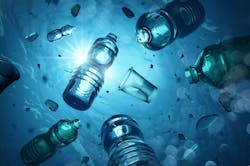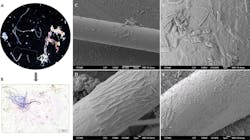Modeling Targets Marine Microplastics Accumulation
One of the key challenges in studying how plastic fragments interact with the marine environment is modeling how they accumulate in sediments.
A study carried out by researchers at the department of engineering, Ehime University, Japan, has revealed the 75-year accumulation rate history of microplastics from 0.3–5mm in coastal sediments — and the importance of phytoplankton in that process.
Describing their work in a recent issue of Science of The Total Environment, the researchers note previous studies of coastal sediment cores found accumulation rates have increased with rises in plastic production and/or regional populations.
However, they also point out that correlations between the rates and bioactivities or ocean dynamics, which are crucial for modeling the microplastic sinking process, have not been examined.
The researchers’ answer was to spend two years extracting and analyzing sedimentary cores at a depth of 70 meters from the Beppu Basin that lies off the northeast coast of Kyushu, one of Japan's five main islands.
By measuring the ages of different sedimentary layers and extracting the microplastics in them, the scientists were able to clarify the change in the number of microplastics that had sunk to the seafloor — per square meter per year — from 1940 to 2015. The 210 Pb dating of the sediment was cross-checked by time control with Cs-137 radioactivity peaks.
The first microplastics found were in the 1958–1961 sedimentary layer, coinciding with a period of high economic growth in Japan.
“We found that a long-term linear increasing trend with an approximately 20-year variation overlapped with significant peaks around 1990 and 2014 with the first polypropylene microplastic fragment detected from a 1958.8–1961.0 CE sediment layer,” they wrote.
The maximum rate was 203 pieces m2/yr with an abundance of 86 pieces/kg dry sediment in 2014. Smaller fragments in the size range of 0.3–2.0 mm are consistently dominant in terms of the accumulation rate throughout the 1955–2015 period, accounting for 85.3 % of the total accumulation rate.
Three major polymers — polyethylene, polypropylene and polystyrene — accounted for 96.6 % of the total.
Phytoplankton in seawater played an important role in the 20-year variation. Years with more phytoplankton also had more microplastic sedimentation. The researchers assume this is due to the formation of biofilms of phytoplankton and other microorganisms on the microplastics surface, resulting in the acceleration of microplastic sedimentation.
Based on the microplastic accumulation rates and concentration in the seawater, the mean sinking velocity of microplastics was estimated to be in the order of 10 meters/day.
“Our results will contribute to significant progress in modeling the microplastic sinking process by offering the first field measurement-based mean sinking velocity and significant correlations between the rate and bioactivity-related signals,” their study concludes.
Meanwhile, a recent study carried out by French researchers focused on the bacteria that colonize microfibers floating in the Mediterranean Sea (Figure 1).
Led by marine sciences researcher Maria Luiza Pedrotti of Sorbonne Université, Paris, the study found that on average over 2,600 bacteria from almost 200 species colonize each microfiber, including one that potentially causes food poisoning.
Writing in a recent issue of PLOS One, Pedrotti and her colleagues explain that synthetic and natural microfibers from plastic pollution, the textile industry and fishing activities have increased dramatically in the environment, becoming the most common type of particles in the ocean. These microfibers, they write, likely pose a threat to aquatic ecosystems and human health, because once they become colonized by microorganisms, they smell like food and are consumed by marine organisms. Due to their persistence, the microfibers likely build up in marine organisms as they move through the food chain.
The researchers used advanced microscopy techniques and DNA sequencing to identify the different microorganisms they found.
What surprised them most was finding Vibrio parahaemolyticus, a potentially dangerous bacterium that causes food poisoning from seafood. It is the first report of this pathogenic species on microfibers from the Mediterranean Sea and its discovery is important for assessing health risks because the bacterium’s presence can be a threat to bathing and seafood consumption.
The study also raises the question of the environmental risk of microfibers. “The increasing amount of persistent plastic waste in the environment may be transporting dangerous bacteria and other pollutants throughout the ocean, thus increasing the risk of contamination compared to short-lived natural particles, such as wood or sediments,” the authors write.
“The role of climate change also has an influence on the spread of this potentially pathogenic bacteria. Studies have shown that temperature has a significant correlation with the increase of Vibrio species and the emergence of infections. At the time we found this Vibrio, coastal summer temperatures ranged from 25.2–26.5°C [77.35–79.7°F], while this year, at the same location, they reached 29°C [84.2°F],” noted Pedrotti.
About the Author
Seán Ottewell
Editor-at-Large
Seán Crevan Ottewell is Chemical Processing's Editor-at-Large. Seán earned his bachelor's of science degree in biochemistry at the University of Warwick and his master's in radiation biochemistry at the University of London. He served as Science Officer with the UK Department of Environment’s Chernobyl Monitoring Unit’s Food Science Radiation Unit, London. His editorial background includes assistant editor, news editor and then editor of The Chemical Engineer, the Institution of Chemical Engineers’ twice monthly technical journal. Prior to joining Chemical Processing in 2012 he was editor of European Chemical Engineer, European Process Engineer, International Power Engineer, and European Laboratory Scientist, with Setform Limited, London.
He is based in East Mayo, Republic of Ireland, where he and his wife Suzi (a maths, biology and chemistry teacher) host guests from all over the world at their holiday cottage in East Mayo.


